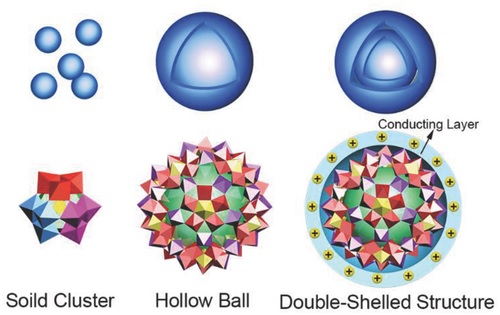兰亚乾教授课题组在SMALL METHODS发表研究论文
Investigation of the Enhanced Lithium Battery Storage in a Polyoxometalate Model: From Solid Spheres to Hollow Balls
Liu, WJ (Liu, Wen-Jing)[ 1 ] ; Yu, G (Yu, Ge)[ 1 ] ; Zhang, M (Zhang, Mi)[ 1 ] ; Li, RH (Li, Run-Han)[ 1 ] ; Dong, LZ (Dong, Long-Zhang)[ 1 ] ; Zhao, HS (Zhao, Hui-Si)[ 1 ] ; Chen, YJ (Chen, Yong-Jun)[ 1 ] ; Xin, ZF (Xin, Zhi-Feng)[ 1 ] ; Li, SL (Li, Shun-Li)[ 1 ] ; Lan, YQ (Lan, Ya-Qian)[ 1 ]*(兰亚乾)
[ 1 ] Nanjing Normal Univ, Sch Chem & Mat Sci, Jiangsu Key Lab New Power Batteries, Jiangsu Collaborat Innovat Ctr Biomed Funct Mat, Nanjing 210023, Jiangsu, Peoples R China
SMALL METHODS,201811,2(11)
Materials with hollow structures are generally considered more conducive to lithium-ion storage than solid materials, but there is no suitable crystal model system to illustrate it. Herein, it is successfully simulated by utilizing polyoxometalate models to compare the lithium-ion battery performances. New crystals, EMI-PMo12 (EMI: 1-ethyl-3-methylimidazolium) with solid sphere and EMI-Mo72V30 and EMI-Mo-132 with hollow structures, are synthesized. In order to increase their electronic conductivity, the composites EMI-PMo12@rGO, EMI-Mo72V30@rGO, and EMI-Mo-132@rGO (rGO: reduced graphene oxide) can be prepared by introducing rGO. The composite EMI-Mo72V30@rGO delivers a reversible capacity of 1145 mAh g(-1) at 100 mA g(-1), and the capacity retentions are nearly 100% at 2000 mA g(-1) for over 500 cycles. This study not only provides a promising avenue toward manufacturing and developing new-generation electrode materials in lithium-ion storage but also proposes a mechanism toward comparing their performances at the molecular level.

文章链接:
https://onlinelibrary.wiley.com/doi/full/10.1002/smtd.201800154
版权与免责声明:本网页的内容由收集互联网上公开发布的信息整理获得。目的在于传递信息及分享,并不意味着赞同其观点或证实其真实性,也不构成其他建议。仅提供交流平台,不为其版权负责。如涉及侵权,请联系我们及时修改或删除。邮箱:sales@allpeptide.com